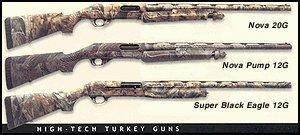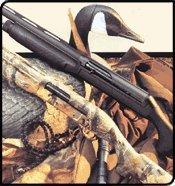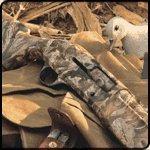2002 Blasts From Benelli!
Benelli U.S.A. made a huge blast at this year's SHOT show with the introduction of several new guns for the avid sportsman. Benelli's company motto reads, Performance Worth The Price. Here's a wring out of some of the hot new innovations from Benelli this year, plus some great shotgun facts you can put to good use in the field this season.
photo by benelli
HIGH-TECH TURKEY GUNS
Benelli's lineup of specialty shotguns is sure to please the most discriminating turkey hunting enthusiast. Versatility is a key component of each Benelli turkey gun. Each model digests a variety of ammunition (powerhouse magnums to field loads) with reliable performance.
Super Mags: Super Black Eagle turkey guns excel with the heavy-hitting 3.5-inch magnum turkey loads, but also give optimal performance with 3-ingh or 2 3/4 inch shotshells. The Super Black Eagle's 24-inch barrel is easily maneuvered in tight cover and delivers dense patterns downrange, where it counts most. The Nova 12-gauge gives pump —action fans the option of shooting the heaviest 3.5-inch ammo, 3 or 2 and ® shells interchangeably.
3-Inch Magnums: Southpaws get equal billing with their right-handed counterparts in the turkey woods with the Benelli M1 Field 12 gauge. These fast-handling guns come with your choice of a 21-inch or 24- inch barrel.
20 Gauge Fans: Youth and small-framed shooters are not the only turkey hunters going afield today with 20-gauge guns. Every year, more veteran turkey hunters rely on their calling skills to work birds in close. They also enjoy the carrying comfort of a lightweight gun.
This year you you can get most Benelli turkey guns in the Advantage Timber High Definition Camo! For ballistics tables on the above guns mentioned, visit Benelli USA on the web.
With the new HD pattern 'burned' into this game blaster, it should be a big hit for hunting enthusiasts!
photo by benelli
A CLOSER LOOK AT THE SUPER BLACK EAGLE
Even after a decade, the Benelli Super Black Eagle's legendary engineering is still the standard to meet in a 3 Ω inch autoloading 12-gauge shotgun. From 2 ® inch, 3 dram, 1 1/8 oz. Field loads to the heaviest 3 Ω inch magnums, flawless performance is the benchmark set by this unique shotgun.
The Benelli inertia recoil system is the heart of this shotgun's great success. Simple, reliable and rock solid, this system does not balk at changes in ammunition or temperature, making the Super Black Eagle a truly universal hunting shotgun.
The Super Black Eagle has grown from one shotgun to a range of models for a variety of specialized hunting tasks. A wide selection of finishes and barrel lengths are offered for upland, waterfowl and turkey hunting. Plus, left-hand and specialized slug shooting models have been produced to meet the demads of shooters who want nothing but a Super Black Eagle.
Since its introduction more than 10 years ago, the Sper Black Eagle continues to be the 12-gauge 3 /2-inch autoloading shotgun that truly does it all. Its stock has a recess for easy installation of a mercury recoil reducer. This accessory is also available for the M1 Field (fits only synthetic field stocks.) Available in Advantage Timber High Definition.
An optional mercury filled recoil reducer can be easily installed in the M1 Field and other selections from Benelli USA.
photo by benelli
A CLOSER LOOK AT THE M1 FIELD
Benelli's M1 Field shotguns are no-nonsense tools that combine firepower and ruggedness in a package that's all business.
The M1 Field is offered in non-reflective matte blue with either satin-finished walnut, black synthetic, or in full coverage Advantage Timber HD. The black and camouflage versions are fitted with sling studs for easy carrying in woods or marsh.
An optional mercury filled recoil reducer can be easily installed. This coupled with a husky ventilated rubber recoil pad, softens felt recoil of the heaviest magnums.
Barrels are in 21, 24, 26, and 28-inch lengths, all with stepped ventilated ribs and supplied with five choke tubes.
The M1 Field also is offered in a 24-inch rifled slug version (1:28: twist) that is fitted with adjustable sights. The slug version is available as a complete gun, or an optioal barrel is available for conversion.
When you need the right tool for the job, nothing beats the versatility of the Benelli M1 Field.
Southpaws can now make the grade shooting Benelli's left-handed versions of its most popular models including the Super Black Eagle, M1 Field and the classy Montefeltro.
photo by benelli
THE LEFTY CONSIDERATION
For years, left-handed shooters have suffered with the restrictions imposed by most autoloading shotguns. Safeties and side shell ejection created an awkward situation and made follow-up shots difficult. Benelli has responded with not one, but three left-handed versions of their most popular 12-gauge autoloading shotguns.
Beginning with the ultimate in autoloaders, the 3 Ω inch Super Black Eagle and 3-inch Montefeltro, are offered in a wide range of configurations, for use on a variety of game. Even the solidly built and highly functional 3-inch M1 Field is offered to the left-handed shooter. New for 2002, Advantage High Definition camouflage gives southpaws even more gunning options.
{C}
{C}
The Nova Pump, reliability to the maximum degree!
photo by benelli
THE NOVA PUMP GETS BETTER
Perhaps the pump shotgun was an American invention, but it took Italian engineering and design to bring it into the 21st century. The Benelli Nova in 12-gauge 3 Ω inch is nothing less than revolutionary.
The heart of this revolution is the rotating bolt head that locks directly into the barrel, sealing the chamber against the power of the mightiest 3 Ω-inch load. This system is the heart of every Benelli autoloader. Twin action bars ensure slick, non-binding pump cycling. The action is surrounded by a one-piece stock/receiver made from a glass/polymer matrix that encapsulates a durable steel insert.
Rugged and rust-free, the Nova's receiver allows bolt and action bars to glide freely in self-lubricating polymer channels. The result is a mooth and lightning-fast action.
Unique features abound and Benelli quality and innovation are present everywhere in the Nova's design. From waterfowl to turkey and even slug hunting for deer, the Nova is ready for all this new century has to offer.
{C}
{C}
Tom Knapp appears regularly at shooting shows across the country. For more information on Knapp and Benelli, hit www.benelliusa.com!
photo by benelli
TOM KNAPP--TOP GUN FOR BENELLI
Tom Knapp has utilized unique Benelli technology and his extraordinary abilities to accomplish a feat that ranks with those of shooting legends Annie Oakley, Adolph Topperwein, and Herb Parsons.
He has established two world records with two different Benelli shotguns, and hand-thrown aerial clay targets. WR #1: Tom inaugurated his professional relationship with Benelli in 1993 by setting a World Record in the semi-automatic shotgun class. Holding his Benelli M1 Super 90 in his left hand, he threw nine standard clays into the air with his right hand and then struck each with asingle shot in just 2.3 seconds!
WR#2: In 1999, Benelli introduced its amazing new technology in the Nova Pump shotgun and Tom began to prepare for another unbelievable feat. On July 19, 2000, Tom Knapp, with his manually-operated Nova Pump in one hand, threw eight clays simultaneously himself, and broke all eight clays individually before they hit the ground. This astounding World Record was accomplished in an amazing 2.1 seconds! To see where Knapp will be performing near you, visit Benelli's upgraded website.
{C}
{C}

CAP-TIPPING HINTS FROM BENELLIUSA.com
SWING AND LEAD
Many shotgunners have wondered how much displacement of the pattern is caused by the motion of the barrel as the shot is fired. Everyone has noticed, when throwing an object from a moving car, that its path has both an outward component from the force of the throw and a forward component from the motion of the car.
This same effect applies to shot patterns. If, for example, a shooter fired on a target crossing 30 yards distant with a load producing a muzzle velocity of 1300 f.p.s., and swung the barrel at 10 m.p.h., the initial direction of the shot charge would be altered by about 26 minutes of angle, or about 8" at 30 yards.
It readily can be seen that this effect adds only a little to the forward allowance necessary to hit the target. In shot gunning, there is no substitute for lead.
SHOT PENETRATION
It has been thought by some hunters that small shot penetrates better because its small cross- section will encounter less resistance.
This idea is quite incorrect. The fallacy in it is obvious when it is carried to its logical conclusion; that a round cannonball would penetrate a much shorter distance than a small shot pellet. The belief would be correctly founded if penetration by shot pellets took place as the result of an outside force applied to the pellets during penetration, pushing them through the target. This situation does not exist.
The only force carrying a projectile through its target arises from its own velocity and weight. Assuming like velocities, then the only factors making for different penetrations by non-deforming round shot will be weight and area. The weights of spheres of the same material will be to each other as the cubes of their diameters. However, the areas they present will be only as the squares of their diameters.
With the available force varying as the diameter cubed, and the resistance varying only as the diameter squared, it is obvious that the penetration will, be as D3 divided by D2, which equals D itself. That is, penetration goes up strictly in accordance with the diameter of the shot. This amply confirmed fact applies to penetration both in solid substances and in air, and is the reason why large shot retain their velocity in flight better than small shot.
SHOT SPREAD DEFINED
Shooters often want a rule of thumb to estimate shot spread at a given range. So many variables are involved -- choke, velocity, shot hardness, etc., that a firm rule is almost impossible to devise. A good rough rule, however, is this one. When fired from a full-choke gun, the pattern will spread roughly 1" per yard. When fired from an improved-cylinder gun, it will spread roughly 1 ®" per yard. Other degrees of choke will spread proportionally.
It should be noted that this applies to any gauge, since extreme spread is little affected by gauge. The larger gauges simply have the ability to fill in the pattern with more shot.
SHOTGUN TERMS
action - the moving parts that allow you to load, fire and unload your shotgun. (See Breech, Chamber, Trigger)
barrel selector - determines which barrel of a double barrel gun will fire first.
blacking/bluing - the blue coloration applied to protect gun barrels.
bore - in simple terms the interior diameter of a gun barrel, which will vary according to the gun's design and intended use. The size of the bore is indicated by the term gauge. Also someone who goes on interminably about shooting to the exclusion of all other subjects.
breech - portion of the barrel into which a cartridge is loaded.
broken gun - in a hinge type gun, where the barrels are dropped open and clear of the action, exposing the chambers to view.
butt - the rear of the shoulder end of the gun's stock.
comb - the side of the stock that fits against your cheek.
chamber - part of the barrel that contains the cartridge at the instant of firing.
choke - the degree of narrowing or constriction of the bore at the muzzle end of the barrel, intended to increase the effective range of the gun. (See Full, Modified, and Improved Cylinder)
ejector - the mechanism on shotguns by which spent shot cases are automatically ejected from the gun when it is opened after firing.
forearm - the part of the stock that lies under the barrel.
full choke - the tightest constriction or narrowing of the bore, producing the greatest effective range.
grip - the narrow portion of the stock held with the trigger hand.
gauge - the term used to describe the interior diameter of the bore. The smaller the gauge number, the larger the bore size. Modern shotguns are available in 10, 12, 16, 20 and 28 gauge. An exception is the .410 bore shotgun, which is actually a 67 gauge.
improved cylinder - least constricted or narrowed choke causing shot pattern to widen relatively quickly.
modified choke - moderate constriction or narrowing of the bore.
muzzle - the end of the barrel from which the shot exits.
over-and-under - a two-barreled shotgun with one barrel placed over the other.
pump - a type of action that loads and ejects shells by "pumping" the forearm of the stock back and forth.
recoil - the force with which the gun moves backwards into the shoulder when fired.
safety - a mechanical device incorporated into a firearm design to help prevent an accidental discharge.
semi-automatic - a type of action which uses the energy from the shell that being fired to eject the spent case, cock the action and then reload a fresh catridge without any additional action on the part of the shooter, also called self-loading. Semi-automatics are noted for minimal recoil.
shot - round projectiles, usually of lead or steel. Depending on shot size and load, a shell can contain from 45 to 1,170 shot.
shot pattern - the concentration of shot measured in a circle at a given range, usually 30 to 40 yards.
side-by-side - a shotgun with two barrels sitting side by side. In Great Britain, the standard game shooting weapon.
stock - the "handle" of the shotgun, the part held to the shoulder, comprising the butt, comb, grip, and forearm.
shotshell or shell - the ammunition fired by shotguns, consisting of five components: the case, primer, powder charge, wad, and shot.
trigger - the portion of the lock mechanism which when pulled by the shooters finger mechanism releases the sear and/or firing pin to discharge the firearm.












